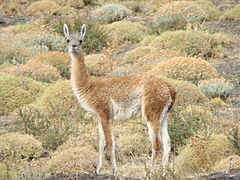Lama
| Lama[1] | |||||
| G. Cuvier, 1800[2] | |||||
 Przedstawiciel rodzaju – gwanako andyjskie (Lama guanicoe) | |||||
| Systematyka | |||||
| Domena | |||||
|---|---|---|---|---|---|
| Królestwo | |||||
| Typ | |||||
| Podtyp | |||||
| Gromada | |||||
| Podgromada | |||||
| Rząd | |||||
| Podrząd | wielbłądokształtne | ||||
| Rodzina | |||||
| Plemię | Lamini | ||||
| Rodzaj | lama | ||||
| Typ nomenklatoryczny | |||||
Camelus glama Linnaeus, 1758 | |||||
| |||||
| Gatunki | |||||
| |||||
Lama[15] (Lama) – rodzaj ssaka z rodziny wielbłądowatych (Camelidae).
Zasięg występowania
Rodzaj obejmuje gatunki występujące w stanie dzikim Ameryce Południowej[16][17][18].
Morfologia
Długość ciała 190–229 cm, długość ogona 18–27 cm, wysokość w kłębie 90–130 cm; masa ciała 90–220 kg[17].
Systematyka
Etymologia
- Lama (Lacma, Llama, Llacma): peruwiańska nazwa llama dla lamy, od keczuańskiej nazwy llama dla lam[19].
- Auchenia (Aucheria, Auchenias): gr. αυχενιος aukhenios „szyjny”, od αυχην aukhēn „szyja”[20]. Gatunek typowy: Camelus glama Linnaeus, 1758; młodszy homonim Auchenia Thunberg, 1789 (Coleoptera).
- Guanaco: hiszpańska nazwa guanako dla gwanako, od keczuańskiej nazwy wanaku dla gwanako[7]. Gatunek typowy: Camelus guanicoe P.L.S. Müller, 1776.
- Vicunia: hiszpańska nazwa vicuña dla wikunii, od keczuańskiej nazwy wik’uña dla wikunii[21]. Nowa nazwa dla Lama G. Cuvier, 1800.
- Dromedarius: łac. dromas, dromadis „dromader”, od gr. δρομας καμηλος dromas kamēlos „biegnący wielbłąd”, od δρομας dromas „biegnący”[22]. Nowa nazwa dla Auchenia Illiger, 1811.
- Neoauchenia: gr. νεος neos „nowy”; rodzaj Auchenia Illiger, 1811[23]. Nowa nazwa dla Auchenia Illiger, 1811.
Podział systematyczny
Do rodzaju należą następujące występujące współcześnie gatunki[16][15]:
- Lama guanicoe (P.L.S. Müller, 1776) – gwanako andyjskie
- Lama glama (Linnaeus, 1758) – lama andyjska – gatunek udomowiony
Opisano również wymarły gatunek żyjący w plejstocenie w Ameryce Południowej[24]:
- Lama castelnaudii (P. Gervais, 1855)
Uwagi
Przypisy
- ↑ Lama, [w:] Integrated Taxonomic Information System [online] (ang.).
- ↑ G. Cuvier: Lecons d’anatomie comparée. T. 1. Paris: Baudouin, 1800, s. tab. 1. (fr.).
- ↑ F. Hemming. Opinion 258. Rejection for nomenclatorial Purposes of the work by Frisch (J. L.) published in 1775 under the title Das Natur-system der Vierfüssigen Thiere. „Opinions and declarations rendered by the International Commission on Zoological Nomenclature”. 5, s. 55–72, 1954. (ang.).
- ↑ J.L. Frisch: Das Natur-System der Vierfüßigen Thiere. Glogau: Christian Friedrich Günther, 1775, s. 4. (niem.).
- ↑ F. Tiedemann: Zoologie: zu seinen Vorlesungen entworfen. Allgemeine Zoologie, Mensch und Säugthiere. Landshut: In der Weberichen Buchhandlung, 1808, s. 420. (niem.).
- ↑ J.K.W. Illiger: Prodromus systematis mammalium et avium: additis terminis zoographicis utriusque classis, eorumque versione germanica. Berolini: Sumptibus C. Salfeld, 1811, s. 103. (łac.).
- ↑ a b G. Perry: Arcana, or, The museum of natural history: containing the most recent discovered objects. Embellished with coloured plates, and corresponding descriptions. With extracts relating to animals, and remarks of celebrated travellers; combining a general survey of nature. London: Printed by George Smeeton for James Stratford, 1811, s. ryc. 68. (ang.).
- ↑ J.G. Fischer von Waldheim: Zoognosia tabulis synopticis illustrata, in usum praelectionum Academiae imperialis medico-chirugicae mosquensis edita. Cz. 3. Mosquae: Nicolai S. Vsevolozsky, 1814, s. 353. (łac.).
- ↑ J.K.W. Illiger. Ueberblick der Säugethiere nach ihrer Verbreitung über die Welth. „Abhandlungen der physikalischen Klasse der Königlich-Preussischen Akademie der Wissenschaften”. 1804–1811, s. 48, 1815. (niem.).
- ↑ C.S. Rafinesque: Analyse de la nature, or, Tableau de l’univers et des corps organisés. Palerme: Aux dépens de l’auteur, 1815, s. 55. (fr.).
- ↑ F. Cuvier: Dictionnaire des sciences naturelles, dans lequel on traite méthodiquement des différens êtres de la nature, considérés soit en eux-mêmes, d’après l’état actuel de nos connoissances, soit relativement à l’utilité qu’en peuvent retirer la médecine, l’agriculture, le commerce et les artes. Suivi d’une biographie des plus célèbres naturalistes. T. 59. Paris & Strasbourg: F. G. Levrault & Le Normant, 1829, s. 512. (fr.).
- ↑ J.G. Wagler: Natürliches System der Amphibien, mit vorangehender Classification der Säugethiere und Vögel. Ein Beitrag zur vergleichenden Zoologie. München, Stuttgart und Tübingen: In der J.G. Cotta’scchen Buchhandlung, 1830, s. 31. (niem.).
- ↑ J.A. Wagner. Bericht über die neuesten Leistungen von Lund, bezüglich der gegenwärtigen wie der ausgestorbenen Säugthier-Fauna Brasiliens.. „Archiv für Naturgeschichte”. 9 (1), s. 349, 1843. (niem.).
- ↑ F. Ameghino. Mamíferos y aves fósiles argentinas. — Especies nuevas, adiciones y correcciones. „Revista Argentina de Historia Natural”. 1, s. 242, 1891. (ang.).
- ↑ a b Nazwy zwyczajowe za: W. Cichocki, A. Ważna, J. Cichocki, E. Rajska-Jurgiel, A. Jasiński & W. Bogdanowicz: Polskie nazewnictwo ssaków świata. Warszawa: Muzeum i Instytut Zoologii PAN, 2015, s. 169. ISBN 978-83-88147-15-9. (pol. • ang.).
- ↑ a b C.J. Burgin, D.E. Wilson, R.A. Mittermeier, A.B. Rylands, T.E. Lacher & W. Sechrest: Illustrated Checklist of the Mammals of the World. Cz. 2: Eulipotyphla to Carnivora. Barcelona: Lynx Edicions, 2020, s. 384. ISBN 978-84-16728-35-0. (ang.).
- ↑ a b W. Franklin: Family Camelidae (Camels). W: D.E. Wilson & R.A. Mittermeier (redaktorzy): Handbook of the Mammals of the World. Cz. 2: Hoofed Mammals. Barcelona: Lynx Edicions, 2011, s. 235–238. ISBN 978-84-96553-77-4. (ang.).
- ↑ D.E. Wilson & D.M. Reeder (redaktorzy): Genus Lama. [w:] Mammal Species of the World. A Taxonomic and Geographic Reference (Wyd. 3) [on-line]. Johns Hopkins University Press, 2005. [dostęp 2021-05-02]. (ang.).
- ↑ Palmer 1904 ↓, s. 363.
- ↑ Palmer 1904 ↓, s. 128.
- ↑ Palmer 1904 ↓, s. 707.
- ↑ Palmer 1904 ↓, s. 245.
- ↑ Palmer 1904 ↓, s. 452.
- ↑ P. Gervais: Recherches sur les mammifères fossiles de l’Amérique méridionale. Paris: P. Bertrand, 1855, s. 41. (fr.).
Bibliografia
- T.S. Palmer. Index Generum Mammalium: a List of the Genera and Families of Mammals. „North American Fauna”. 23, s. 1–984, 1904. (ang.).
Media użyte na tej stronie
Autor: (of code) -xfi-, Licencja: CC BY-SA 3.0
The Wikispecies logo created by Zephram Stark based on a concept design by Jeremykemp.

